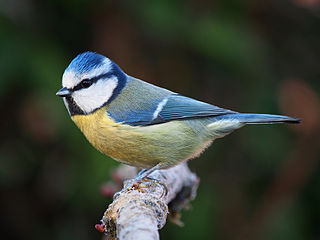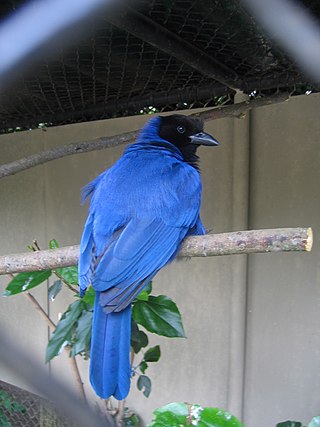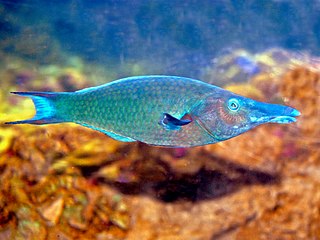
The black-winged kite, also known as the black-shouldered kite, is a small diurnal bird of prey in the family Accipitridae best known for its habit of hovering over open grasslands in the manner of the much smaller kestrels. This Palearctic and Afrotropical species was sometimes combined with the Australian black-shouldered kite and the white-tailed kite of North and South America which together form a superspecies. This kite is distinctive, with long wings; white, grey and black plumage; and owl-like forward-facing eyes with red irises. The owl-like behaviour is even more pronounced in the letter-winged kite, a nocturnal relative in Australia. Although mainly seen on plains, they are sometimes seen on grassy slopes of hills in the higher elevation regions of Asia. They are not migratory, but show nomadism in response to weather and food availability. They are well adapted to utilize periodic upsurges in rodent populations and can raise multiple broods in a single year unlike most birds of prey. Populations in southern Europe have grown in response to human activities, particularly agriculture and livestock rearing. Now present in SouthWest France

The Eurasian blue tit is a small passerine bird in the tit family, Paridae. It is easily recognisable by its blue and yellow plumage and small size.

The white-tailed kite is a small raptor found in western North America and parts of South America. It replaces the related Old World black-winged kite in its native range.

Labidochromis caeruleus is a species of cichlid endemic to the central western coastal region of Lake Malawi in East Africa. It is also known as lemon yellow lab, the blue streak hap, the electric yellow or yellow prince, depending on the colour morph. A naturally occurring yellow-coloured variant from Lion's Cove is one of the most popular cichlids amongst aquarium hobbyists.

The purple honeycreeper is a small Neotropical bird in the tanager family Thraupidae. It is found in the tropical New World from Colombia and Venezuela south to Brazil, and on Trinidad. A few, possibly introduced birds have been recorded on Tobago.

The common krait, also known as Bengal krait, is a species of highly venomous snakes of the genus Bungarus in the Elapidae family native to the Indian subcontinent. It is one of the Big Four Indian snakes that inflict the most snakebites on humans in Pakistan, India and Bangladesh.

The azure jay is a passeriform bird of the crow family, Corvidae. It is found in the Atlantic Forest, especially with Araucaria angustifolia, in south-eastern Brazil, far eastern Paraguay and far north-eastern Argentina. It is the state bird of Paraná.

The four venomous snake species responsible for causing the greatest number of medically significant human snake bite cases on the Indian subcontinent are sometimes collectively referred to as the Big Four. They are as follows:
- Russell's viper, Daboia russelii
- Common krait, Bungarus caeruleus
- Indian cobra, Naja naja
- Indian saw-scaled viper, Echis carinatus

Cubiceps caeruleus, the blue fathead or cubehead, is a species of driftfish native to the Pacific and Atlantic oceans. It is a pelagic fish that can be found at depths of from 20 to 250 metres. It mostly feeds on salps. This species can reach a length of 25.6 centimetres (10.1 in) TL.

Pseudophilautus caeruleus, commonly called blue thigh shrub frog, is a species of frogs in the family Rhacophoridae. It is endemic to Sri Lanka.

The large hawk-cuckoo is a species of cuckoo in the family Cuculidae. It has a wide breeding distribution from temperate Asia along the Himalayas extending to East Asia. Many populations winter further south. They are known for their loud and repetitive calls which are similar to that of the common hawk-cuckoo but do not rise in crescendo. They are also somewhat larger and adults can be readily told apart from the smaller common hawk-cuckoo by the black patch on the chin. They are brood-parasites of babblers and laughing-thrushes.

The blue whistling thrush is a bird in the Old World flycatchers family Muscicapidae that is found in the mountains of Central Asia, South Asia, China and Southeast Asia. It is known for its loud human-like whistling song at dawn and dusk. The widely distributed populations show variations in size and plumage with several of them considered as subspecies. Like others in the genus, they feed on the ground, often along streams and in damp places foraging for snails, crabs, fruits and insects.

The giant pitta is a species of bird in the family Pittidae.

Whitaker's shrew is a species of mammal in the family Soricidae. It is found in Western Sahara, Algeria, Morocco, Tunisia. Its natural habitats are subtropical or tropical dry shrubland, rocky and sandy coasts. It is a fairly common species and the International Union for Conservation of Nature has rated its conservation status as being of "least concern".
Setchellanthus caeruleus is a species of pungent shrub with large blue flowers. It is placed alone in the genus Setchellanthus, which is in turn, is placed alone in the family Setchellanthaceae. It is endemic to Mexico.

Xanthagaricus is a genus of fungi in the family Agaricaceae. The genus contains 23 species found in India, Sri Lanka, Bangladesh, Thailand, China and Africa. Originally described in 1984 by Belgian mycologist Paul Heinemann as Hymenagaricus subgen. Xanthagaricus, it was promoted to generic status in 1997.

Gomphosus caeruleus, the green birdmouth wrasse, is a species of wrasse belonging to the family Labridae. It can be found in the aquarium trade.

Xanthagaricus flavosquamosus is a species of the fungal family Agaricaceae.This species is described from China.
Symphodus caeruleus is a species of marine ray-finned fish, a wrasse from the family Labridae. It is endemic to the Azores in the eastern Atlantic Ocean.
The emerald wrasse is a species of marine ray-finned fish, a wrasse from the family Labridae. It is endemic to the eastern Atlantic Ocean where it is found in the Macaronesian archipelagoes of the Canary Islands and Madeira, including the Savage Islands. This species was formerly thought to be found in the Azores but the specimens there were found to belong to a separate species Symphodus caeruleus.
















